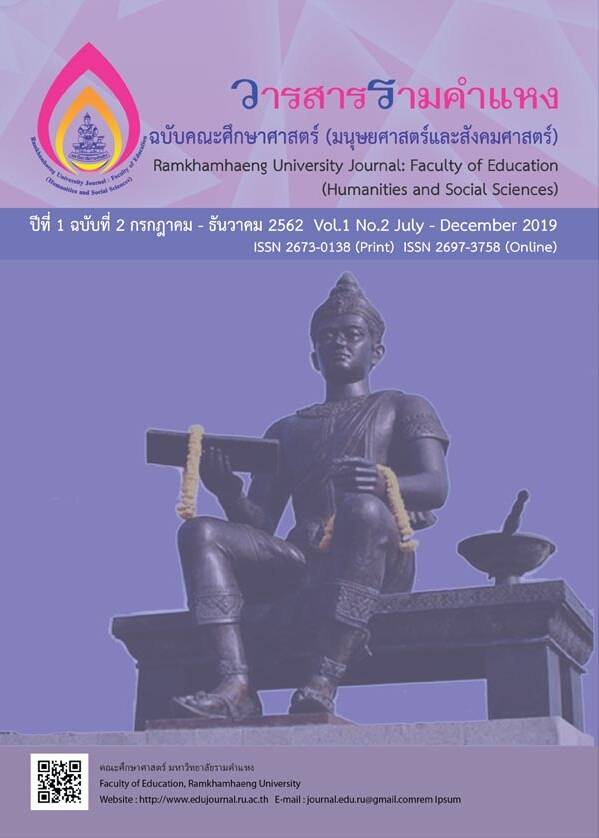Physical Fitness Correlated with the Health of Lower Secondary School Students at Demonstration Schools in Bangkok Metropolis Under the Jurisdiction of the Office of the Higher Education Commission
Main Article Content
Abstract
1. Physical fitness as correlated with the health of male students aged 13-15 years exhibited means as follows: BMI (kilograms/m3) was at 19.97, 19.22, and 20.01, respectively. Subcutaneous fat (percentages) was at 16.46, 22.16, and 22.68, respectively.
Sit-ups (times) were at 27.87, 27.86, and27.89, respectively. Push-ups (times) were at 15.79, 15.82, and 15.87, respectively. Sit and reach (centimeters) was at 5.79, 6.38, and 5.75, respectively. Long- distance running (minutes) was at 11.94, 12.34, and 11.92, respectively.
2. Physical fitness as correlated with the health of female students aged 13-15 years exhibited means as follows: BMI (kilograms/m3) was at 18.38, 19.99, and 20.03, respectively. Subcutaneous fat (percentages) was at 15.21, 20.42, and 23.23, respectively. Sit-ups (times) were at 26.42, 27.92, and 27.81, respectively. Push-ups (times) were at 16.34, 15.80, and 15.95, respectively. Sit and reach (centimeters) was at 8.23, 5.78, and 5.78, respectively. Long-distance running (minutes) was at 12.30, 11.93, and 11.93, respectively.
3. The classification of the level of physical fitness as correlated with the health of male students, aged 13-15 years By Health-Related Physical Fitness Test for Thai children aged 7-18 years showed that BMI was at an appropriate level for all three age ranges. The percentage of subcutaneous fat was at a proportional level, rather fat, and rather fat, respectively. The strength and abdominal muscular endurance were at a low level for all three levels. The strength and endurance of arm muscles and upper body muscles were at a low level for all three levels. The flexibility of tendons at joints and bones were at low levels for all three levels. The strength and endurance of the respiratory system and the circulatory system were at a moderate, moderate, and low level, respectively.
4. The classification of the level of physical fitness as correlated with the health of female students aged 13-15 years By Health-Related Physical Fitness Test for Thai children aged 7-18 years was as follows: BMI was at an appropriate level for all three age ranges. The percentage of subcutaneous fat was at the levels of rather thin, appropriate, and rather fat, respectively. The strength and endurance of abdominal muscles were at a moderate level for all three levels. The strength and endurance of arm muscles and upper body muscles were at a low level for all three levels. The flexibility of tendons at joints and bones was at moderate, low, and low for all three levels. The levels of strength and endurance of the respiratory system and the circulatory system were at a moderate level for all three levels
Downloads
Article Details

This work is licensed under a Creative Commons Attribution-NonCommercial-NoDerivatives 4.0 International License.
ผู้ส่งบทความ (และคณะผู้วิจัยทุกคน) ตระหนักและปฎิบัติตามจริยธรรมการวิจัยอย่างเคร่งครัด ทั้งนี้บทความ เนื้อหา ข้อมูล ข้อความ ภาพ ตาราง แผนภาพ แผนผัง หรือข้อคิดเห็นใดๆ ที่ปรากฎในบทความ เป็นความคิดเห็นและความรับผิดชอบของผู้ส่งบทความ กองบรรณาธิการไม่จำเป็นต้องเห็นตามเสมอไป และไม่มีส่วนรับผิดชอบใดๆ โดยถือเป็นความรับผิดของของเจ้าของบทความเพียงผู้เดียว
References
กระทรวงสาธารณสุข, กรมอนามัย, สํานักส่งเสริมสุขภาพ. (2544). เกณฑ์การประเมินโรงเรียนส่งเสริมสุขภาพ นนทบุรี: ผู้แต่ง.
กัลยาณี โนอินทร์. (2560). ภาวะนํ้าหนักเกินและโรคอ้วนในวัยเรียนและวัยรุ่นไทย. วารสารพยาบาลทหารบก, 18 (ฉบับพิเศษ), 1-8.
เจริญ กระบวนรัตน์. (2531), ร่างกายกับผลที่ได้รับจากการออกกําลังกาย, วารสารสุขศึกษา พลศึกษาและสันทนาการ 12(2), 79-88.
เจริญทัศน์ จินตนเสรี. (2538). วิทยาศาสตร์การกีฬาสําหรับผู้ฝึกสอนกีฬาและนักกีฬา, กรุงเทพมหานคร: ศูนย์ วิทยาศาสตร์การกีฬา การกีฬาแห่งประเทศไทย.
พิชิต ภูติจันทร์ และคณะ. (2533), วิทยาศาสตร์การกีฬา, กรุงเทพมหานคร: สํานักพิมพ์ต้นอ้อ สํานักงานกองทุนสนับสนุนการสร้างเสริมสุขภาพ. (2549). แบบทดสอบและเกณฑ์มาตรฐานสมรรถภาพทางกายที่ สัมพันธ์กับสุขภาพสําหรับเด็กไทย อายุ 7-18 ปี (พิมพ์ครั้งที่ 2). กรุงเทพมหานคร: โรงพิมพ์องค์การรับส่งสินค้าและพัสดุภัณฑ์.
สํารวล รัตนาจารย์. (2520), สมรรถภาพทางกาย, กรุงเทพมหานคร: มหาวิทยาลัยศรีนครินทรวิโรฒประสานมิตร, คณะพล ศึกษา, ภาควิชาพลศึกษา,อุดมศิลป์ แสงศรีนาม. (2531), วิ่งสู่วิถีชีวิตใหม่ กรุงเทพมหานคร: สํานักพิมพ์หมอชาวบ้าน.
Krejcie, R. V., & Morgan, D. W. (1970). Determining Sample Size for Research Activities. Educational and Psychological Measurement, 343), 607-610.

